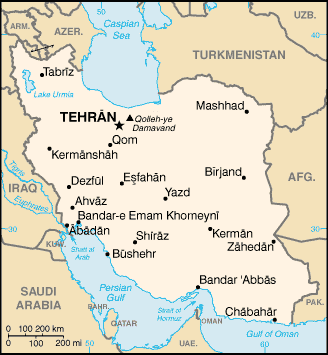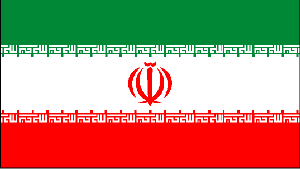
|
Iran
Background:
Known as Persia until 1935, Iran became an Islamic republic in 1979 after the
ruling shah was forced into exile. Conservative clerical forces subsequently
crushed westernizing liberal elements. Militant Iranian students seized the US
Embassy in Tehran on 4 November 1979 and held it until 20 January 1981. During
1980-88, Iran fought a bloody, indecisive war with Iraq over disputed
territory. Key current issues affecting the country include the pace of
accepting outside modernizing influences and reconciliation between clerical
control of the regime and popular government participation and widespread
demands for reform.
Location:
Middle East, bordering the Gulf of Oman, the Persian Gulf, and the Caspian Sea,
between Iraq and Pakistan.
Area: Total: 1.648 million sq km , land: 1.636 million sq km, water: 12,000 sq
km.
Area - comparative: Slightly larger than Alaska.
Land boundaries: Total: 5,440 km, border countries: Afghanistan 936 km,
Armenia 35 km, Azerbaijan-proper 432 km, Azerbaijan-Naxcivan exclave 179 km,
Iraq 1,458 km, Pakistan 909 km, Turkey 499 km, Turkmenistan 992 km.
Coastline: 2,440 km; note - Iran also borders the Caspian Sea (740 km).
Climate and Terrain:
Climate: Mostly arid or semiarid, subtropical along Caspian coast.
Terrain: Rugged, mountainous rim; high, central basin with deserts, mountains;
small, discontinuous plains along both coasts.
People:
Population: 66,622,704.
Ethnic groups: Persian 51%, Azeri 24%, Gilaki and Mazandarani 8%, Kurd 7%, Arab
3%, Lur 2%, Baloch 2%, Turkmen 2%, other 1% .
Religions: Shi'a Muslim 89%, Sunni Muslim 10%, Zoroastrian, Jewish, Christian,
and Baha'i 1%.
Languages: Persian and Persian dialects 58%, Turkic and Turkic dialects 26%,
Kurdish 9%, Luri 2%, Balochi 1%, Arabic 1%, Turkish 1%, other 2%.
Government:
Government type: Theocratic republic.
Capital: Tehran.
Independence: 1 April 1979.
Economy overview:
Iran's economy is a mixture of central planning, state ownership of oil and
other large enterprises, village agriculture, and small-scale private trading
and service ventures. President KHATAMI has continued to follow the market
reform plans of former President RAFSANJANI and has indicated that he will
pursue diversification of Iran's oil-reliant economy although he has made
little progress toward that goal. The strong oil market in 1996 helped ease
financial pressures on Iran and allowed for Tehran's timely debt service
payments.
Statistics:
Telephones - main lines in use: 6.313 million.
Telephones - mobile cellular: 265,000.
Radio broadcast stations: AM 72, FM 5, shortwave 5.
Radios: 17 million.
Television broadcast stations: 28 (plus 450 low-power repeaters).
Televisions: 4.61 million.
Internet users: 250,000.
Railways: Total: 6,130 km.
Highways: Total: 140,200 km, paved: 49,440 km, unpaved: 90,760 km.
Airports: 322, with paved runways: 118, with unpaved runways: 204.
Heliports: 11.
Return to Visiting Locations
|

